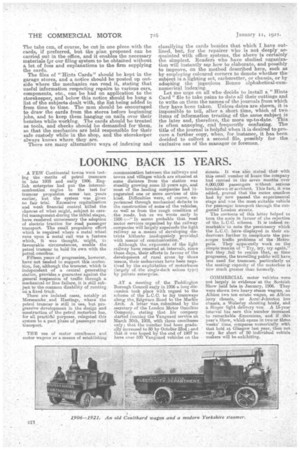, LOOKING .. BACK 15 YEARS.
Page 14

If you've noticed an error in this article please click here to report it so we can fix it.
.A FEW Continental towns were testing the -merits of petrol tramcars• in late 1905 and early 1906. English enterprise had put the internalcombustion engine to the test for tramcar propulsion some ten years earlier, but the system was given no fair trial. Excessive capitalization and, weak financial control killed the chances of what might, subject to careful management during the initial stages, have rendered unnecessary the adoption of electrio traction for road passenger transport. The small propulsive effort which is required where a metal wheel runs upon a metal rail was a feature which, it was thought, might, in favourable circumstances, enable the petrol traenear to hold its own with the petrol omnibus.
Fifteen years of progression, however, have not tended to support this coeteie tion, for, although the tramcar. which is independent of a, central generating station, provides.a guarantee against the general suspension of traffic through a mechanical or line failure, it is still subject to the common disability of running ori a fixed track.
There are isolated cases, notably at Morecambe_ and Hastings, where the petrol tramcar is still in use, bat progressive-development in the design and construction of the petrol motorbus has, for all practieal purposes, relegated this system to a past phase of passenger read transport.
THE me of motor omnibuses and motor wagons as a means of establishing
communication between the railways and towns and villages which are situated at some distance from the station was steadily growing some 15 years ago, an4 most of the. leading companies had inaugurated one or snare services of this kind. Difficulties were of c01,B6 experienced through mechanical course, defects in the construction of some of the vehicles, as well as from the rough condition of the roads, but as we wrote early in 1906 :—" It, seems probable that,. road motor services organized by the railway companies will largely supersede the light railway as a means of developing districts hitherto inadequately provided with means of comMunication."
Although the.exponents of the light reilway have renewed at interval's, since those days, their efforts in favour of the development of rural areas by those means, their endeavours have been negatived by the exploitation of motorbuses (largely of the single-deck saloon type) by private enterprise.
AT a. meeting of the Paddington Borough Council early in 1906 a. long discussion took place with regard to the scheme of the L.C.C. to lay tramways along the. ..Edgware Road to the Marble Arch:. A letter was\ siebmitted by the secretary of the London Motor Omnibus Company, stating that his' company started running the Vanguard service on March 30th, 1905, with three omnibuses only; that the number had -been gradually increased to 50 by October 23edand that it was hoped by the end of 190'7 to have over 5(1) Vanguard vehicles on the
Streets. It was alio stated thatwith this, small number of buses the company had carried in the seven months over 4,000,000 passengers without serious breakdown us' accident. This feet, it was
added, proved that the motor omnibus•had by now passed the experimental stage and was the most suitable vehicle for passenger transport through the congested Lon74on streets. The contents of this letter helped to turn the scale in favour of the rejection of the L.C.C. scheme. It is indeed remarkable to note the persistency which the L.C.C: have displayed in their endeavours further to complicate the passenger traffic problems of the Metropolis. They apparently work on the
. simple-maxim ` Try, try, try again," but they . fail to realize that, as time progresses, the travelling public will have less need for tramcars,' particularly as the seating capacity of the motorbus is now much greater than fermerly.
COMMERCIAL motor vehicles were not largely in evidence atthe Scottish Show held late in January, 1906. They were shown two heavy-steam wagons, an Albion two ton estate wagers, an Albion lorry chassis, an Arrol-Johnston bus chassie, a Wolee!ey shooting brake and a Singer light delivery van. A 1g-year interval has seen this number increased to remarkable dimensions, and if this year's Show, which opens in two or three weeks' time, compares numerically with that held at Glasgow last year, then not very far short of 50 individual vehicle makers Will be-exhibiting.
































